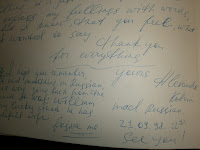 |
| George Lyttleton's handwriting |
Commonplace books are not bundles of stuff. They bear the actual imprint of the owner. And they're mis-named. As George Lyttleton asked of his friend Rupert Hart-Davis, 'why is it called a commonplace book when practically nothing in it is commonplace?' (GWL, 2002). In his own commonplace book, he noted the breeding habits of rabbits (p.29) and a Japanese student's interpretation of the instruction 'stand on your own feet' as 'I must float on my own bladder' (p.58). Does anybody out there still keep a commonplace book? I do hope so.
Another type of book long out of fashion is the visitors' book. Our visitors' book is, after the husband, children, dogs and budgie (the budgie? who am I kidding) the thing I'd want to rescue from a fire. My husband and I have kept it from the day we were married. Nobody has to write a remark - I hate doing that myself - only a signature from each person - none of this signing for the whole family - and the dates of visitors' arrival and departure. Apart from being a highly effective weapon when arguing over the last time we saw so and so, our book follows the trajectory of our lives through the signing of names: my late parents-in-law and mother; my father; nieces and nephews from faltering splodge to elegant scrawl; friends from afar; whole pages for christenings, weddings, funerals. We also have three memorable pages from three memorable visits, filled with the outpourings of Russian pianist Alexander Kobrin. He came, alone, aged 17, to stay for the Scottish Piano Competition. It was his first adult victory (he was the youngest competitor), and he went on to win a string of other competitions, culminating in the Van Cliburn. I'm glad he ignored the 'name only' rule. His pages brim with him.
 |
| Alexander Kobrin's entry in our visitors book |
And what opportunities for raising danders visitors' books supply! The rule in our house (as in my parents') has always been that once you marry, if you return to the parental home, you sign the visitors' book. Our older daughter, married last year, didn't turn a hair. Friends turned several hairs on her behalf. 'Bloody hell, Katie! She has to sign to visitors' book in her own home? That's awful!' My rather weak protestation that she now has her own home did not placate. In some eyes, I'm now an Officially Awful Mother.
 |
| People who stayed for Eliza's 21st |
Lyttleton, G. (2002) The Commonplace Book of George Lyttleton, York, Stone Trough Books









